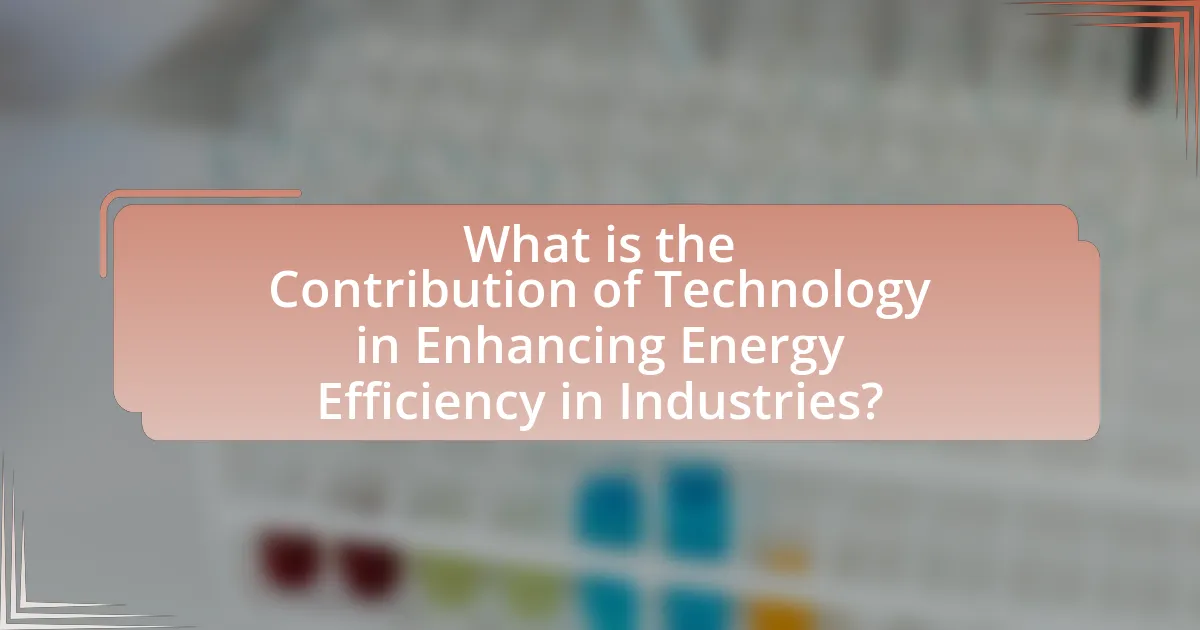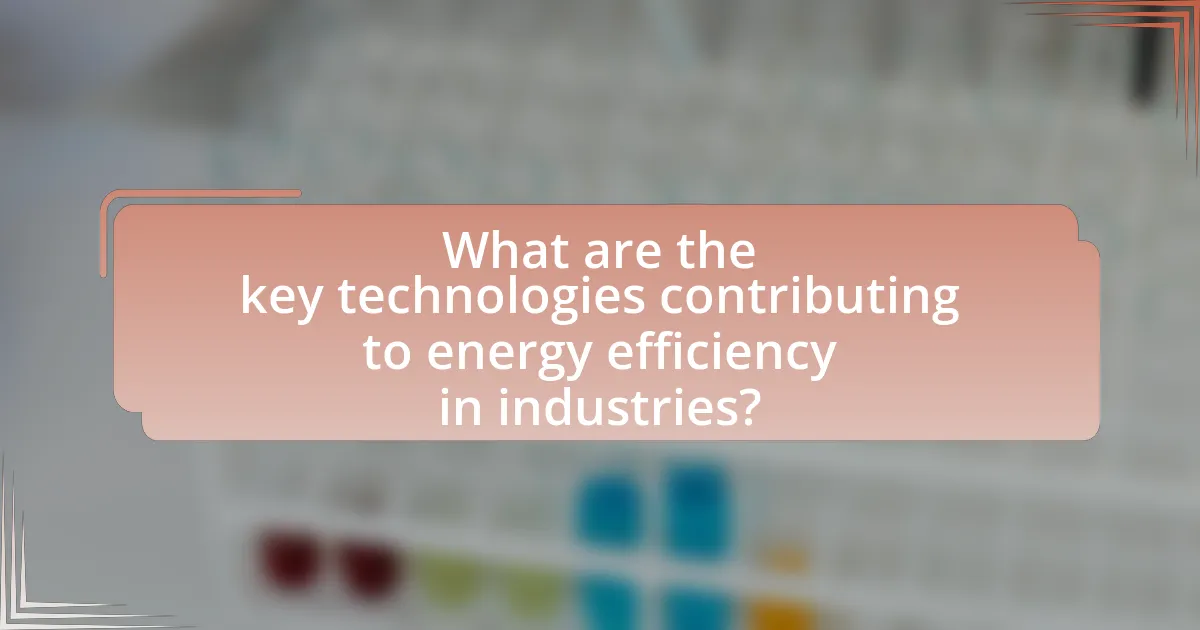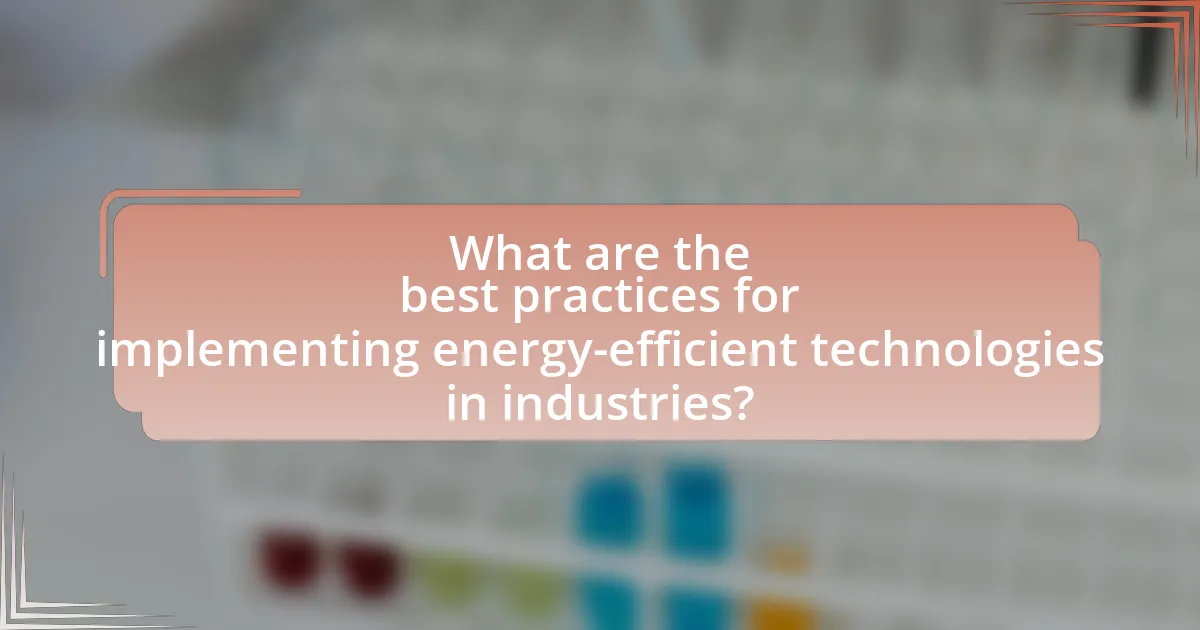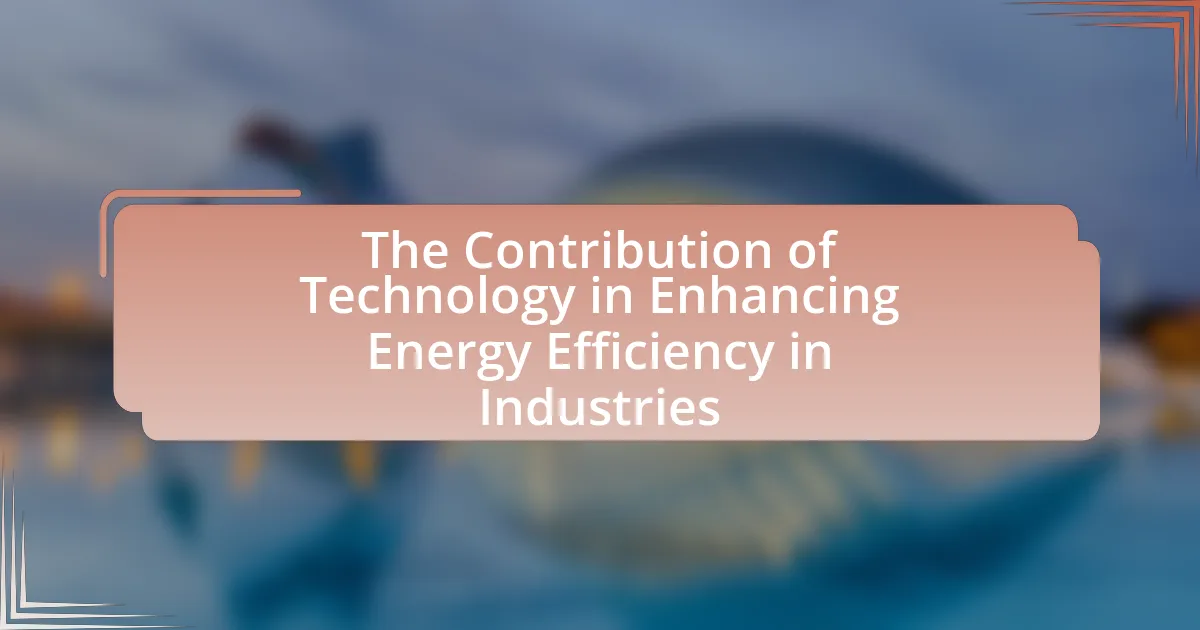The article examines the significant role of technology in enhancing energy efficiency within industrial sectors. It highlights how advanced manufacturing technologies, such as automation, artificial intelligence, and IoT devices, optimize processes, reduce waste, and enable real-time monitoring, leading to substantial energy savings. Key technologies discussed include smart grids, energy management systems, and high-efficiency equipment, all of which contribute to reduced operational costs and improved environmental sustainability. The article also addresses the challenges industries face in adopting these technologies and outlines best practices for implementation, emphasizing the importance of leadership and employee engagement in fostering a culture of energy efficiency.

What is the Contribution of Technology in Enhancing Energy Efficiency in Industries?
Technology significantly enhances energy efficiency in industries by optimizing processes, reducing waste, and enabling real-time monitoring. For instance, the implementation of advanced manufacturing technologies, such as automation and artificial intelligence, allows industries to streamline operations, leading to a reduction in energy consumption by up to 30% in some cases. Additionally, smart sensors and IoT devices facilitate continuous monitoring of energy usage, enabling companies to identify inefficiencies and adjust operations accordingly. According to a report by the International Energy Agency, energy efficiency improvements in industrial sectors could lead to a cumulative energy savings of 20% by 2040, underscoring the critical role of technology in achieving these efficiencies.
How does technology influence energy efficiency in industrial settings?
Technology significantly enhances energy efficiency in industrial settings by enabling advanced monitoring, automation, and optimization of processes. For instance, the implementation of Internet of Things (IoT) devices allows real-time data collection and analysis, leading to informed decision-making that reduces energy consumption. According to a report by the International Energy Agency, industries that adopt smart technologies can achieve energy savings of up to 20% through improved operational efficiency and reduced waste. Additionally, energy management systems facilitate the identification of inefficiencies, allowing for targeted interventions that further enhance energy performance.
What types of technologies are commonly used to improve energy efficiency?
Technologies commonly used to improve energy efficiency include smart grids, energy management systems, high-efficiency HVAC systems, LED lighting, and advanced insulation materials. Smart grids optimize electricity distribution and consumption, reducing waste and enhancing reliability. Energy management systems enable real-time monitoring and control of energy use, leading to significant savings. High-efficiency HVAC systems consume less energy while maintaining comfort levels. LED lighting uses up to 75% less energy than traditional incandescent bulbs, significantly lowering electricity costs. Advanced insulation materials minimize heat loss, improving overall building energy performance. These technologies collectively contribute to substantial reductions in energy consumption across various industries.
How do these technologies integrate with existing industrial processes?
Technologies enhance energy efficiency in industries by integrating advanced automation, data analytics, and IoT systems into existing processes. These technologies enable real-time monitoring and optimization of energy consumption, allowing industries to identify inefficiencies and reduce waste. For instance, a study by the International Energy Agency found that implementing smart sensors and automation can lead to energy savings of up to 30% in manufacturing processes. This integration not only streamlines operations but also aligns with sustainability goals, demonstrating a clear pathway for industries to improve energy efficiency while maintaining productivity.
Why is energy efficiency important for industries?
Energy efficiency is crucial for industries because it reduces operational costs and minimizes environmental impact. By implementing energy-efficient technologies, industries can lower energy consumption, which directly translates to decreased utility bills. For instance, according to the U.S. Department of Energy, energy-efficient practices can reduce energy use in manufacturing by 10-30%, leading to significant cost savings. Additionally, enhancing energy efficiency contributes to sustainability goals by lowering greenhouse gas emissions, thereby supporting regulatory compliance and improving corporate reputation.
What are the economic benefits of enhanced energy efficiency?
Enhanced energy efficiency leads to significant economic benefits, including reduced operational costs and increased competitiveness. By implementing energy-efficient technologies, industries can lower their energy consumption, which directly translates to lower utility bills. For instance, a study by the American Council for an Energy-Efficient Economy (ACEEE) found that energy efficiency measures can save businesses up to 30% on energy costs. Additionally, enhanced energy efficiency can stimulate job creation in the energy sector, as investments in energy-efficient technologies often require skilled labor for installation and maintenance. Furthermore, improved energy efficiency can lead to increased productivity, as more efficient systems often operate more reliably and with less downtime. Overall, these economic benefits contribute to a more sustainable and resilient industrial sector.
How does energy efficiency impact environmental sustainability?
Energy efficiency significantly enhances environmental sustainability by reducing energy consumption and minimizing greenhouse gas emissions. When industries adopt energy-efficient technologies, they lower their reliance on fossil fuels, which are major contributors to climate change. For instance, according to the International Energy Agency, improving energy efficiency in industrial processes can reduce global energy demand by up to 30% by 2040, leading to a substantial decrease in carbon dioxide emissions. This reduction not only helps mitigate climate change but also conserves natural resources, promoting a more sustainable environment.

What are the key technologies contributing to energy efficiency in industries?
Key technologies contributing to energy efficiency in industries include advanced automation systems, energy management software, and high-efficiency equipment. Advanced automation systems optimize processes by reducing energy consumption through precise control and monitoring, leading to significant energy savings. Energy management software enables industries to track energy usage in real-time, identify inefficiencies, and implement corrective measures, which can result in energy savings of up to 20%. High-efficiency equipment, such as variable frequency drives and energy-efficient motors, can reduce energy consumption by 30% or more compared to traditional equipment. These technologies collectively enhance operational efficiency and lower energy costs, demonstrating their critical role in improving energy efficiency in industrial settings.
How do automation and control systems enhance energy efficiency?
Automation and control systems enhance energy efficiency by optimizing operational processes and reducing energy waste. These systems utilize real-time data and advanced algorithms to monitor and adjust energy consumption based on demand, leading to significant reductions in energy usage. For instance, a study by the U.S. Department of Energy found that implementing automation in industrial settings can lead to energy savings of 10% to 30%. Additionally, automation allows for predictive maintenance, which minimizes downtime and ensures equipment operates at peak efficiency, further contributing to energy conservation.
What role do sensors and IoT play in monitoring energy usage?
Sensors and IoT play a critical role in monitoring energy usage by providing real-time data collection and analysis. These technologies enable industries to track energy consumption patterns, identify inefficiencies, and optimize resource allocation. For instance, smart meters and connected devices can measure energy usage at granular levels, allowing for precise monitoring and management. According to a report by the International Energy Agency, implementing IoT solutions can lead to energy savings of up to 30% in industrial settings by facilitating better decision-making and automation.
How can predictive maintenance reduce energy consumption?
Predictive maintenance can reduce energy consumption by optimizing equipment performance and minimizing downtime. By using data analytics and machine learning, predictive maintenance identifies potential equipment failures before they occur, allowing for timely interventions that keep machinery operating efficiently. For instance, a study by the U.S. Department of Energy found that predictive maintenance can lead to energy savings of 10-20% in industrial settings by ensuring that machines run at optimal conditions, thus reducing unnecessary energy use associated with inefficient operations.
What is the impact of renewable energy technologies on industrial energy efficiency?
Renewable energy technologies significantly enhance industrial energy efficiency by reducing reliance on fossil fuels and optimizing energy consumption. These technologies, such as solar panels and wind turbines, enable industries to generate clean energy on-site, which lowers operational costs and minimizes energy waste. For instance, a study by the International Renewable Energy Agency (IRENA) found that integrating renewable energy sources can improve energy efficiency in industrial processes by up to 30%. This improvement is attributed to the ability of renewable technologies to provide stable and predictable energy supply, which allows for better energy management and utilization in manufacturing processes.
How do solar and wind energy systems contribute to energy savings?
Solar and wind energy systems contribute to energy savings by generating renewable electricity that reduces reliance on fossil fuels. These systems harness natural resources—solar panels convert sunlight into electricity, while wind turbines capture wind energy—resulting in lower operational costs for industries. For instance, according to the U.S. Department of Energy, businesses that utilize solar energy can save an average of 75% on their electricity bills over time. Additionally, wind energy has been shown to provide cost-effective power, with the levelized cost of wind energy dropping by 70% since 2009, making it a viable alternative to traditional energy sources. This transition not only leads to direct financial savings but also contributes to reduced greenhouse gas emissions, further enhancing overall energy efficiency in industrial operations.
What are the challenges of integrating renewable energy in industrial operations?
Integrating renewable energy in industrial operations faces several challenges, including high initial costs, intermittency of energy supply, and the need for infrastructure upgrades. High initial costs can deter industries from adopting renewable technologies, as investments in solar panels, wind turbines, or energy storage systems can be substantial. The intermittency of renewable energy sources, such as solar and wind, leads to fluctuations in energy availability, complicating the management of energy supply and demand. Additionally, existing infrastructure may require significant upgrades to accommodate renewable energy systems, which can further increase costs and extend project timelines. These challenges are supported by studies indicating that while renewable energy adoption can lead to long-term savings, the upfront financial and logistical hurdles often impede immediate implementation.

What are the best practices for implementing energy-efficient technologies in industries?
The best practices for implementing energy-efficient technologies in industries include conducting energy audits, investing in advanced technologies, and fostering employee engagement. Energy audits identify areas of inefficiency, enabling targeted improvements; for instance, a study by the U.S. Department of Energy found that companies can reduce energy consumption by 10-30% through regular audits. Investing in advanced technologies, such as variable frequency drives and energy management systems, can optimize operations and reduce energy use significantly. Additionally, engaging employees through training and awareness programs can lead to behavioral changes that further enhance energy efficiency, as demonstrated by a report from the International Energy Agency, which highlighted that employee involvement can lead to energy savings of up to 15%.
How can industries assess their current energy efficiency levels?
Industries can assess their current energy efficiency levels by conducting energy audits, which systematically evaluate energy consumption and identify areas for improvement. These audits involve analyzing energy usage data, assessing equipment performance, and comparing energy consumption against industry benchmarks. According to the U.S. Department of Energy, implementing energy audits can lead to energy savings of 5% to 30% in industrial facilities, demonstrating their effectiveness in identifying inefficiencies. Additionally, utilizing energy management software can provide real-time monitoring and analytics, further enhancing the assessment process by allowing industries to track energy performance over time.
What tools and methodologies are available for energy audits?
Energy audits utilize various tools and methodologies to assess and improve energy efficiency. Common tools include energy management software, which tracks energy consumption and identifies inefficiencies, and data loggers that monitor energy use in real-time. Methodologies such as the ASHRAE Level I, II, and III audits provide structured approaches to evaluate energy performance, with Level I focusing on a walkthrough assessment, Level II including detailed analysis and energy modeling, and Level III involving comprehensive measurement and verification. These tools and methodologies are validated by industry standards, such as those set by the American Society of Heating, Refrigerating and Air-Conditioning Engineers (ASHRAE), ensuring their effectiveness in identifying energy-saving opportunities.
How can industries set realistic energy efficiency goals?
Industries can set realistic energy efficiency goals by conducting thorough energy audits to assess current consumption and identify areas for improvement. This process allows organizations to establish a baseline for energy use, which is essential for setting achievable targets. For instance, a study by the U.S. Department of Energy indicates that companies that implement energy management systems can reduce energy consumption by 10-20% within the first year. By leveraging technology such as smart meters and energy management software, industries can continuously monitor performance and adjust goals based on real-time data, ensuring that targets remain attainable and aligned with operational capabilities.
What strategies can industries adopt to foster a culture of energy efficiency?
Industries can foster a culture of energy efficiency by implementing comprehensive training programs for employees that emphasize the importance of energy conservation. These programs can include workshops and seminars that educate staff on energy-saving practices and technologies, leading to increased awareness and engagement. Additionally, industries can adopt energy management systems that monitor and analyze energy usage, allowing for data-driven decisions to optimize energy consumption. Research indicates that organizations that actively involve employees in energy efficiency initiatives can achieve up to a 20% reduction in energy costs, demonstrating the effectiveness of these strategies.
How can employee training and engagement improve energy efficiency outcomes?
Employee training and engagement can significantly improve energy efficiency outcomes by equipping staff with the knowledge and skills necessary to implement energy-saving practices. When employees are trained on energy-efficient technologies and practices, they become more aware of their energy consumption behaviors and can identify areas for improvement. For instance, a study by the U.S. Department of Energy found that organizations that invested in employee training programs saw energy savings of up to 20% due to increased awareness and proactive energy management. Engaged employees are more likely to adopt energy-efficient behaviors, such as turning off equipment when not in use or optimizing machinery settings, leading to reduced energy waste and lower operational costs.
What role does leadership play in promoting energy-efficient practices?
Leadership plays a crucial role in promoting energy-efficient practices by setting a vision and creating a culture that prioritizes sustainability. Effective leaders influence organizational behavior by establishing policies that encourage energy-saving initiatives, allocating resources for energy-efficient technologies, and engaging employees in sustainability efforts. For instance, companies with strong leadership commitment to energy efficiency, such as General Electric, have reported significant reductions in energy consumption and operational costs, demonstrating that leadership directly impacts the successful implementation of energy-efficient practices.
What are the common challenges faced when adopting energy-efficient technologies?
Common challenges faced when adopting energy-efficient technologies include high initial costs, lack of awareness, and insufficient technical expertise. High initial costs often deter organizations from investing in energy-efficient solutions, as they may require significant upfront capital despite long-term savings. Lack of awareness about the benefits and availability of these technologies can lead to underutilization, as many businesses are not informed about potential energy savings and operational efficiencies. Additionally, insufficient technical expertise can hinder the effective implementation and maintenance of energy-efficient systems, as organizations may struggle to find qualified personnel to manage these technologies. According to a report by the International Energy Agency, these barriers significantly impact the rate of adoption, limiting the overall effectiveness of energy efficiency initiatives in various industries.
How can industries overcome financial barriers to technology adoption?
Industries can overcome financial barriers to technology adoption by leveraging government incentives, grants, and subsidies specifically designed to promote energy-efficient technologies. For instance, the U.S. Department of Energy offers various funding opportunities that can cover a significant portion of the costs associated with implementing new technologies. Additionally, industries can explore partnerships with technology providers that offer flexible financing options, such as leasing or pay-as-you-go models, which reduce upfront costs. Research indicates that companies that adopt energy-efficient technologies can achieve cost savings of up to 30% on energy bills, thereby offsetting initial investments over time.
What are the technological limitations that industries may encounter?
Industries may encounter technological limitations such as outdated infrastructure, insufficient integration of advanced technologies, and lack of skilled personnel. Outdated infrastructure can hinder the adoption of energy-efficient technologies, as older systems may not support modern upgrades. Insufficient integration of advanced technologies, like IoT and AI, can lead to inefficiencies in energy management and data analysis. Additionally, a lack of skilled personnel limits the ability to implement and maintain new technologies effectively, which is crucial for enhancing energy efficiency. These limitations can significantly impact an industry’s ability to optimize energy use and reduce operational costs.
What practical steps can industries take to enhance energy efficiency through technology?
Industries can enhance energy efficiency through technology by implementing advanced energy management systems, utilizing energy-efficient equipment, and adopting renewable energy sources. Advanced energy management systems enable real-time monitoring and optimization of energy usage, leading to significant reductions in waste. For instance, a study by the U.S. Department of Energy found that companies using energy management systems can reduce energy consumption by 10-20%. Additionally, replacing outdated machinery with energy-efficient models can lead to lower operational costs and reduced energy consumption; the International Energy Agency reports that energy-efficient technologies can reduce energy use in industrial sectors by up to 30%. Finally, integrating renewable energy sources, such as solar or wind, not only decreases reliance on fossil fuels but also lowers overall energy costs, as evidenced by the fact that the cost of solar energy has dropped by over 80% since 2010, making it a viable option for many industries.


